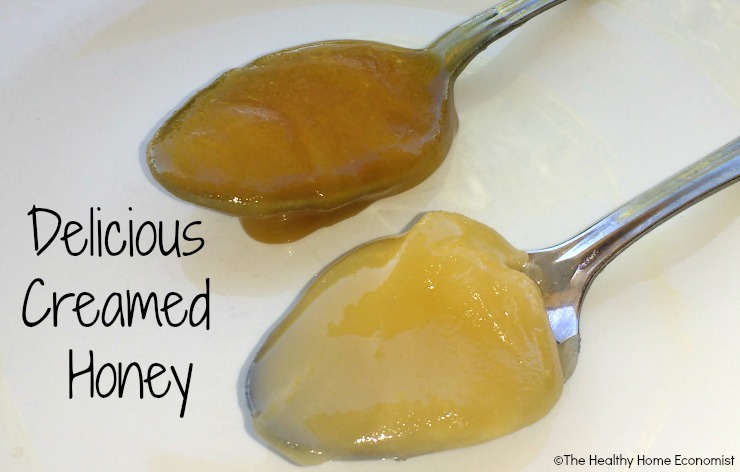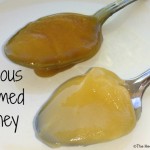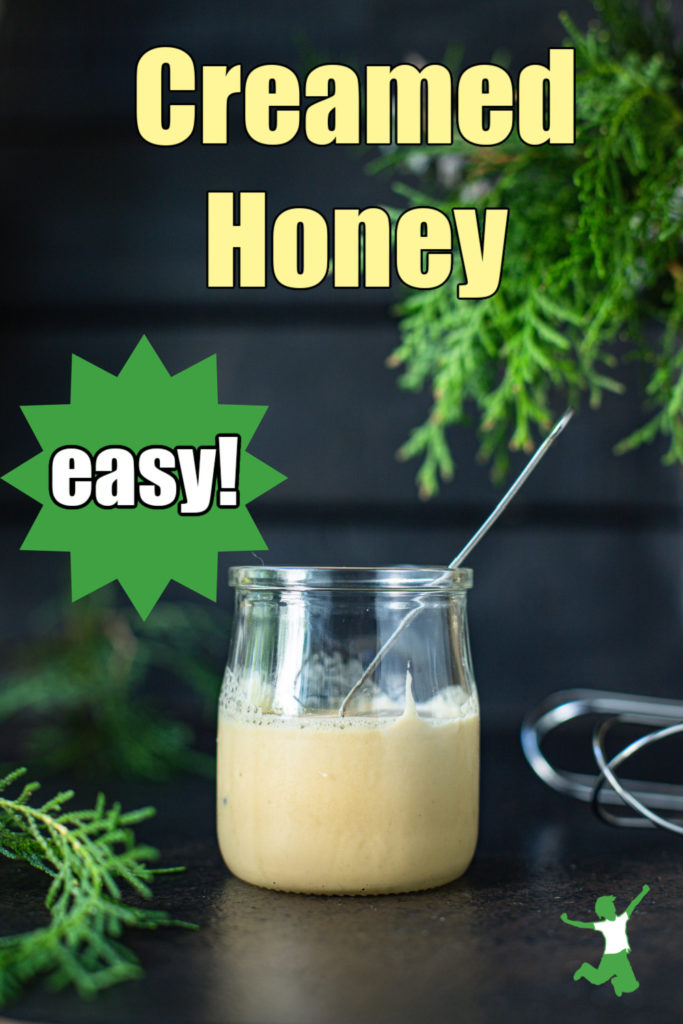How to make creamed honey at home inexpensively and easily that is thick and delicious right off the spoon or spread on your favorite baked goods.

Creamed honey is considered the crème de la crème of raw honey for good reason with a powerful nutritional profile as well as a luscious texture. Making it yourself from raw liquid honey is easy, but never ever whip it!
Consumers consider creamed honey the crème de la crème of raw honey. Often, retailers and wholesalers sell it at a premium price. This is the case no matter whether plain or flavored. Purchasing directly from a local beekeeper or off the shelf at the health food store is still a pricey endeavor.
From a practical standpoint, I prefer creamed honey to liquid honey. This is because its thickness makes less of a mess in the kitchen when the kids are making breakfast or grabbing a spoonful after school.
No sticky drips on the floor, table, or counters to clean up!
From a nutritional point of view, consumers often assume that the premium price of creamed honey indicates a healthier product. This is especially true if flavored with herbs or fruit.
Another common misconception is that whipping liquid honey like butter transforms it into creamed. Adding air to the honey is incorrectly assumed to achieve that delectably smooth texture that is so enjoyable off the spoon or infinitely spreadable on toast.
Is either of these assumptions actually true? Is it possible for honey fans to easily make creamed honey at home from less expensive but just as nutritious, local liquid honey? This would certainly save money! DIY creamed honey would also allow for unique flavor combinations or just to enjoy a fun project with the kids.
Is Creamed Honey More Nutritious or Beneficial?
Many fans are surprised to learn that creamed honey does not confer any additional health benefits compared to liquid honey. There is no difference in terms of quality, nutrition, or natural antibiotic value. Of course, this assumes both are completely unheated and unfiltered.
Texture and thickness are ultimately the only differences between creamed and liquid honey. However, consumers willingly pay more for creamed honey simply because of the dreamy, spoon-worthy texture.
For example, the amazingly delicious, creamed honey we use comes from a variety of organic beekeepers in the United States, Canada, Brazil, and New Zealand (source). It’s a bit pricey, but my kids absolutely love it because it is ultra-thick, mild-tasting, smooth and spreadable. When using raw honey medicinally, however, I prefer seasonal local honey.
The picture above shows a spoon of local creamed honey and commercial creamed honey from the health food store. As you can see, creamed honey can vary quite a bit in thickness and consistency depending on the variety.
In my experience, local honey is more readily available in a liquid state when purchased directly from a beekeeper. Creamed honey usually comes from artisanal producers who might not live in your neck of the woods. Hence, the benefits of raw honey derived from the nectar of plants in your vicinity would be lost.
What if you could easily cream local raw honey purchased inexpensively and in bulk from a beekeeper? Wouldn’t you prefer this instead? I know I do! Here’s a video on sourcing the best raw honey I filmed to show you where to start.
How is Creamed Honey Made?
As mentioned above, a common misconception is that whipping liquid honey is the key to its transformation.
On the contrary, creamed honey is crystallized, not whipped like butter. Whipping liquid honey is actually very damaging as it introduces oxygen, moisture, and potentially pathogenic microbes into the mix. Do not do it! It is very destructive to this living superfood.
Whipping will also not produce quality creamed honey. Be wary of recipes that recommend this approach.
Creaming honey in a traditional manner is very simple. It is a low-temperature process used historically by beekeepers to slow down the natural crystallization of honey without damaging it in the process. If you’ve ever left a jar of raw, liquid honey in the pantry for a long time, you know what I mean. Large chunks of the honey crystallize naturally making pouring very difficult.
Crystallized honey can be re-liquefied by placing the jar in a pan of warm water not to exceed 117 ºF/ 47 ºC. In my experience, though, this is not a convenient process nor is it totally reliable. Larger chunks of crystallized honey do not readily liquefy in a reasonable period of time.
Instead of Creaming Honey, the Honey Industry Heats It
The modern honey industry found the natural crystallization process inconvenient too. The commercial solution is to heat treat honey on a large scale so that it would no longer solidify at all. This keeps industrialized honey looking presentable on store shelves for long periods of time. Of course, the expedient approach of heating honey destroys the enzymes, probiotics, and makes it toxic too. But, in the world of big business, this is inconsequential. Profits are most important to these corporations who figure most consumers don’t know any better.
Unfortunately, the honey industry has taken this dishonest attitude of “what the consumer doesn’t know, lines our pockets really well” an unsavory step further in recent years.
Most large scale honey manufacturers have replaced the honey either partially or entirely with honey-flavored corn syrup! To avoid this scam, you really must source your honey from a local beekeeper, small producer, or reputable retailer to be sure of authenticity. Buying honey from a large store or supermarket chains virtually guarantees that the honey is fake (1).
Be forewarned that according to a beekeeper friend of mine, many of the “tricks” to determine if honey is pure and raw are not actually reliable. The best approach is to read the label to ensure only honey is in the jar in the first place and buying from a reputable source to ensure a raw and unfiltered product.
Crystallized, Liquid or Creamed?
The good news is that like creamed honey, crystallized honey is just as high quality, flavorful and nutritious. This is the case even though large scale manufacturers and some consumers view it as a defect. You absolutely can eat crystallized honey, although the grittiness might cause you not to enjoy it as much. Some folks seem to prefer it. Factors which influence the rate at which raw liquid honey crystallizes include:
- Type of honey: some varieties granulate faster than others. You have probably noticed this if you are like me and keep many jars of different types of honey in the pantry.
- Temperature: Cold temperature speeds up crystallization considerably especially temperatures below 50 ºF/ 10 ºC. If you live in a warmer climate, you probably don’t have as much of an issue with crystallized honey. In warmer climates that regularly get into the 80’s ºF/ 30’s ºC or higher, honey remains runny much longer.
The upside is that if you notice your honey starting to crystallize, it is definitely raw. This is one way to know you’ve got the real thing!
How To Make Creamed Honey
A better solution to commercialized honey, however, is to buy quality raw, local honey.
Then, slow down the natural crystallization process by making it into creamed honey. This imparts a creamy smooth texture naturally. No whipping necessary!
Here’s how it’s done…

Creamed Honey Recipe
Easy recipe for transforming raw, liquid honey into delectable creamed honey.
Ingredients
- 2 cups raw honey must be liquid and unfiltered, preferably local
- 3 Tbl creamed honey crystallized honey may be substituted
- 1-2 tsp freshly ground cinnamon either Ceylon or Cassia, optional
- 1 wide mouth mason jar quart size
Instructions
-
If choosing crystallized honey as the starter for your creamed honey, it must be powdered into fine granules first. You can either use a mortar and pestle to do this, or buy crystallized honey powder instead.
-
Once you have your starter ready, pour the liquid honey into the mason jar. Slowly stir in the starter (either creamed honey or crystallized honey powder).
-
Do not whip or stir too vigorously as air introduced into the process will damage the integrity and flavor of the honey.
-
Continue to stir for about 2-3 minutes. Stir in optional cinnamon (I recommend 2 tsp of freshly ground Ceylon cinnamon and only 1 tsp if you choose the Cassia variety) for another minute or two.
-
Screw on the lid and place in a cool room or basement. The ideal storage temperature for creating creamed honey is about 50 °F/ 10 °C. If you live in a very warm climate, place the jar in a small cooler with an ice pack and change it once per day. Refrigerating will actually slow down the creaming process, so it is preferable not to do this unless it is the only option.
-
After a week or so, you might see a few bubbles forming on top or the color of the honey has become uneven. Like other fermented foods, every batch will tend to be a little bit different so be open to the possibilities Mother Nature has to offer.
-
The most noticeable changes are in the texture and clarity of the honey. It will no longer be clear and will take on a thicker consistency that is creamier and scoopable instead of pourable.
-
Store your creamed honey in the pantry. Avoid storing honey, creamed or not, for long periods of time near windows or on shelves near the stove, refrigerator or other appliances as warmer temperature can cause honey to become less flavorful.
Recipe Notes
If your home is very warm (over 90 °F/ 32 °C), you may wish to store the creamed honey in the refrigerator so it won’t get runny and darken in color. Don’t freeze it as this will change the texture although the nutritional value remains unaltered.
If your home is like ours, no worries as the creamed honey won’t last long enough for these problems to occur even during the hot summertime months!









is it possible to make creamed honey without heating it up and or adding already crystalized honey?
?? this recipe does not involve heating the honey. You must use crystalized honey as that is the “starter” so to speak to make the creamed honey.